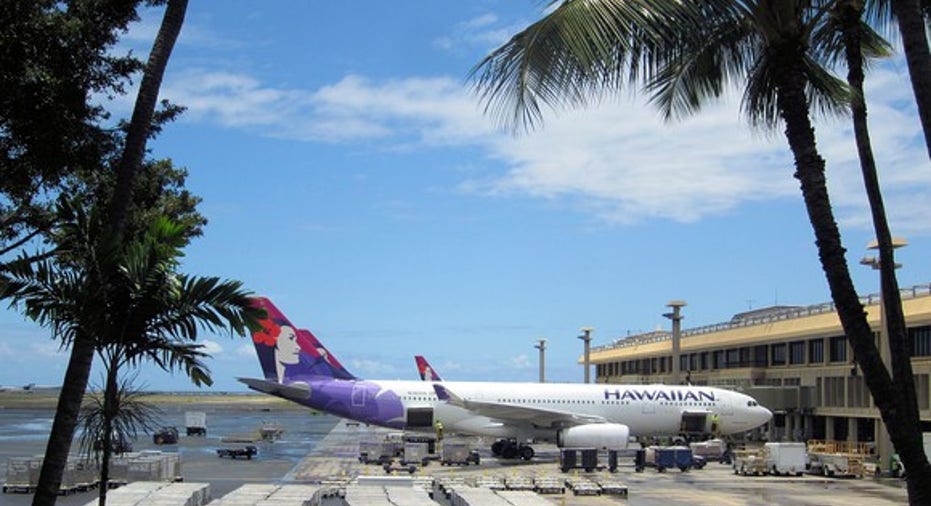Hawaiian Airlines Is Firing on All Cylinders

Over the past two years, surging capacity and falling oil prices have combined to drive unit revenue lower across the U.S. airline industry. Despite these negative industry trends, Hawaiian Holdings (NASDAQ: HA) returned to modest unit revenue growth in Q2 of this year.
Earlier this week, Hawaiian Airlines revealed that demand has become even stronger recently, and it lifted its Q4 unit revenue guidance. This increases the likelihood that Hawaiian will be able to offset the steep cost inflation it's likely to face in 2017.
Hawaiian Airlines' unit revenue is taking off. Image source: The Motley Fool.
Rising demand trends lift unit revenue
Hawaiian Holdings investors have gotten used to positive guidance updates this year, as demand for travel to Hawaii has remained strong.
In July, Hawaiian increased its Q2 unit revenue guidance, calling for a 1% to 2% year-over-year gain in revenue per available seat mile (RASM), up from its initial guidance for a roughly flat RASM performance. Ultimately, Hawaiian reported that RASM rose 1.6% for the quarter.
A similar dynamic played out in Q3. Hawaiian initially projected that RASM would be in the range of down 1% to up 2%; early in October, it revised that forecast, calling for 0.5% to 1.5% RASM growth. The final tally was a 1.3% year-over-year increase.
In both of these quarters, Hawaiian Airlines' unit revenue was at or near the top of the company's guidance range. Moreover, the results were very impressive relative to the unit revenue declines that were prevalent at other airlines. Nevertheless, Hawaiian's unit revenue growth remained modest in absolute terms.
Unit costs are set to rise
Getting unit revenue on a stronger growth trajectory is very important for Hawaiian Airlines because it will face significant cost headwinds in the next year or two. At the company's investor day this week, CFO Shannon Okinaka forecast low- to mid-single-digit growth in adjusted non-fuel unit costs during 2017.
This guidance doesn't include any allowance for a new pilot contract. Earlier this year, the union called for a massive pay increase to put Hawaiian Airlines pilots' pay on par with that of pilots at other major airlines. The cost of that proposal would be $74 million in the first year, according to the airline. The pilot union is becoming increasingly militant in pressuring the company to meet its demands.
Pilot pay raises of this magnitude would add about 5 percentage points to Hawaiian's non-fuel unit cost growth. Hawaiian may be able to negotiate the cost down a bit, but with pilot pay rising at a rapid clip across the industry, it doesn't have much room for maneuvering. Big pilot pay raises are a question of "when," not "if."
Hawaiian Airlines will face high cost inflation in the near future. Image source: Wikimedia Commons.
Additionally, oil prices have started to rise recently. As a result, Hawaiian Airlines will probably face a big increase in fuel costs next year in addition to its non-fuel unit cost growth.
Hawaiian is crushing its guidance
Fortunately, unit revenue growth is accelerating quickly at Hawaiian Airlines. In October, the company projected that RASM would rise 0.5% to 3.5% in Q4. On Monday, the company revised that forecast even higher. Hawaiian now expects RASM to surge 3% to 6% year over year this quarter.
Hawaiian Airlines CEO Mark Dunkerley attributed this guidance increase to strong demand for last-minute Hawaii vacation bookings from customers in the U.S. The company has also seen strong demand in Japan lately. Meanwhile, it hasn't been dragged down by poor performance in any of its other international markets, as has often been the case over the past several years.
Of course, Hawaiian's industry-leading RASM growth this year is setting up tough comparisons for 2017. But it is comforting to see the company exiting 2016 with such strong trends.
To maintain its unit revenue momentum over the next few years, Hawaiian Airlines is rolling out flat-bed first-class seats on all of its A330s (used for long-haul flights) by early 2018.
Hawaiian's new lie-flat first class seats will boost unit revenue. Image source: Hawaiian Airlines.
It also recently announced plans to replace its last eight aging Boeing 767s with smaller A321neos by the end of 2018. This will allow the carrier to better match capacity to demand on lower-traffic routes, boosting unit revenue -- while also dramatically reducing fuel consumption.
Hawaiian Holdings now carries a premium valuation following its strong 2015 and 2016 results. Other faster-growing airlines look like more attractive investment opportunities at this point. Nevertheless, Hawaiian stock could continue grinding higher in the coming years as the company capitalizes on its fleet transition plans.
10 stocks we like better than Hawaiian Holdings When investing geniuses David and Tom Gardner have a stock tip, it can pay to listen. After all, the newsletter they have run for over a decade, Motley Fool Stock Advisor, has tripled the market.*
David and Tom just revealed what they believe are the 10 best stocks for investors to buy right now...and Hawaiian Holdings wasn't one of them! That's right -- they think these 10 stocks are even better buys.
Click here to learn about these picks!
*Stock Advisor returns as of Nov. 7, 2016.
Adam Levine-Weinberg owns shares of Boeing and Hawaiian Holdings and is short January 2017 $50 calls on Hawaiian Holdings. The Motley Fool has no position in any of the stocks mentioned. Try any of our Foolish newsletter services free for 30 days. We Fools may not all hold the same opinions, but we all believe that considering a diverse range of insights makes us better investors. The Motley Fool has a disclosure policy.